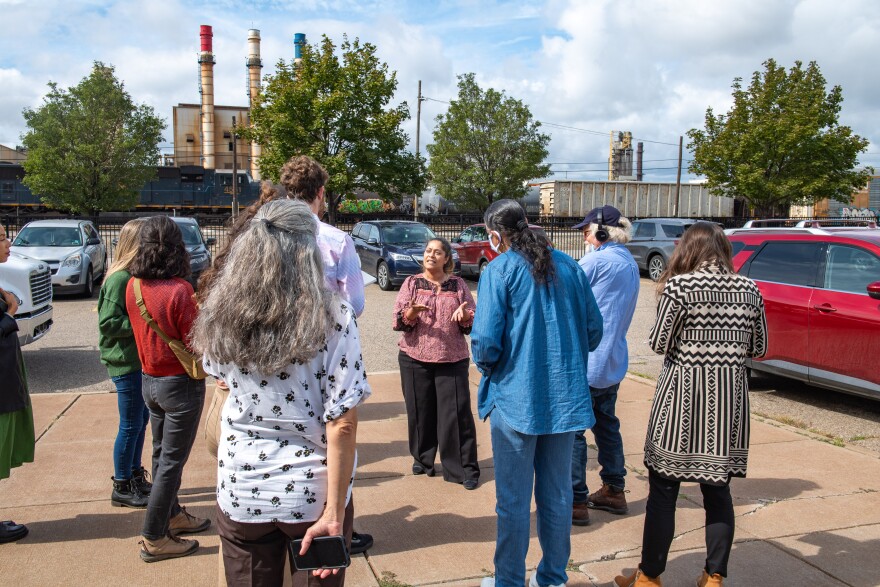The transition to cleaner electric vehicles continues in Wisconsin, as the State Assembly last week agreed to accept nearly $80 million in federal funding to help build more EV charging stations.
During the transition — be it fast or slow — car companies are also being urged to reduce climate change emissions while making vehicles by using what’s called “green steel.”
Our story starts at a car show in the Milwaukee suburb of Greenfield, where Joe Dubaniewicz sits in his 2017 Chevy Volt EV. With the noiseless engine on, he talks about the lack of carbon pollutants coming out of his EV.
Dubaniewicz says he’d also like to see vehicle manufacturing become cleaner. “Better to have it cleaned up by the manufacturers than exposing the nearby community to pollution,” he tells WUWM.
Since Wisconsin doesn’t mass produce any cars, WUWM went to where auto making is still a huge deal — metropolitan Detroit — to hear more from people who live near auto plants or the steelmaking industry. Steel makes up more than half of the weight of a typical car.
Aaron J. Thornton/Getty Images for Industrious Labs
/
Getty Images North America
In the Detroit suburb of Dearborn, activists say there are prominent examples of the health problems that can arise when big industrial plants are too close to neighborhoods. Standing outside a school and community center complex just down the street from a power plant, a Ford auto plant and a Cleveland-Cliffs steel facility, Samra’a Luqman describes what she believes is the toll on people.
“Down the street, a 20-year-old died of breast cancer. To the right of me, kidney cancer. Just last year, another man died of brain cancer. So, we have a cancer cluster. I know it. I’ve seen my family, my neighbors impacted and dying,” Luqman says.
Aaron J. Thornton/Getty Images for Industrious Lab
/
Getty Images North America
Luqman says a 2015 cleanup agreement between the federal government and the steelmaker hasn’t done enough. The U.S. EPA and Justice Department recently announced a proposed modification to resolve Clean Air Act violations at the Dearborn plant. Cleveland-Cliffs would spend more than $100 million to curtail emissions.
A few miles away, community activist Theresa Landrum points toward a nearby plant that changes coal into metallurgical coke for use in steel-making furnaces. The EPA has been after that plant, too, for sulphur dioxide emissions that allegedly violate the Clean Air Act.
Landrum says she hopes car buyers in places like Milwaukee realize the environmental impact of car-making,
“People don’t think of that. They just go buy a shiny new car. But they don’t understand there’s pollution that comes along with the process,” Landrum says.
Aaron J. Thornton/Getty Images for Industrious Labs
/
Getty Images North America
There’s also a climate change angle to cleaning up steel and auto manufacturing. Hilary Lewis is with the advocacy group Industrious Labs, which focuses on heavy industry. Lewis says heat-producing carbon emissions can be reduced by getting coke out of steel-making.
“The leading way to do this today is a process called direct reduced iron, which is taking off in Europe. Europe is the leader in direct-reduced iron plants that are going to run on green-hydrogen. And green hydrogen is a fuel that is made from renewable energy resources like wind and solar,” Lewis says.
Steelmakers like Cleveland-Cliffs contend they’re not ignoring cleaner steel, saying that a process at a newer direct-reduction plant In Toledo contributes to the company’s greenhouse gas reduction initiative.
Still environmental advocates say steelmakers would make bigger changes if huge customers like car and truck makers demanded them.
Screenshot
That’s starting to happen. Last week, Volvo’s Heather Krajewski told a webinar that company supply chain buyers are stepping up their scrutiny of parts connected to a lot of the greenhouse gas carbon dioxide.
“We use a tool called CO2 A.I. So, every buyer in the organization can map our their portfolio for parts that they buy and look at their life cycle analysis,” Krajewski says.
It’s expected to take a while for wider car manufacturers to demand green steel. But with 88 million new auto sales forecast worldwide this year, there would seem to be a chance for big environmental gains in car manufacturing.
In the same way, customer states such as Wisconsin are hoping to reduce tailpipe emissions through more electric or gas-electric hybrid vehicles.




